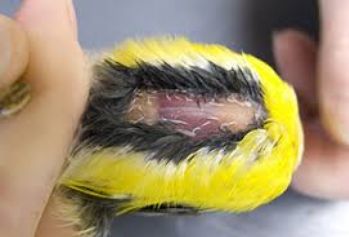
How do birds survive when it’s cold or food is scarce? They live off their fat reserves.
In cold weather, warm-blooded animals burn more energy to maintain their body temperatures. Pound for pound, fat’s the best to burn because it provides twice the energy of protein and carbohydrates. Polar explorers know this, so when they have to travel light they carry fat for food: butter, chocolate and nuts.
Birds prepare for scarcity and cold by eating more and storing fat under their skin. At first the fat is in discrete patches but as the bird gains weight the fat comes a continuous subcutaneous layer. You’ve probably seen this on the chicken you buy at the grocery store.
Shown above is a magnolia warbler in late fall with bulging yellowish fat reserves under its belly skin. This bird was banded and photographed at Powdermill Avian Research Center where the bander blew on its belly feathers to assess the bird’s fat reserves and fitness for migration. (Fat reserve information is noted for all banded birds.)
Large birds can store more fat on their bodies and go longer without eating. A warbler might not survive a day without food in 33o to 50oF temperatures but an American Kestrel with a fat supply can last five.
The champion of fat storage is the male Emperor Penguin who fasts for two to four months during the Antarctic winter while incubating his lone egg and waiting for his mate to return from the sea. He prepared for this feat by nearly doubling his body weight. Good thing he did!
This week it’s been quite cold so we’re all stoking up our fat reserves. That’s why the birds — and we — are so hungry right now.
(photo linked from Powdermill Avian Research Center. Click on the photo to see the original. And my thanks to Frank B. Gill’s book, Ornithology, which supplied much of this information.)
That Mike Horn guy (polar explorer) is insane.
Powdermill is an awesome place, I highly recommend a visit during spring migration, for those who haven’t been there. There is a relatively new green building (park administration?) just down the road, too, which is quite interesting in its use of eco-friendly technologies in its construction and operation. (this info from two years ago, last time I visited the area)
Thank you for an interesting post. I hope to go there someday.
Do birds store fat around their skull?
No, they store it under their skin in places where there’s room for expansion, especially the belly. The skull doesn’t allow for expansion.